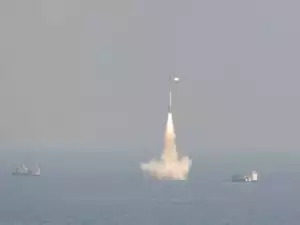The K-4 ballistic missile represents a significant achievement in India’s defense technology, underscoring its growing prowess in strategic deterrence. This nuclear-capable missile, developed by the Defence Research and Development Organisation (DRDO), is designed to enhance the capabilities of India’s submarine-launched ballistic missile (SLBM) arsenal. Its successful tests mark an important milestone in ensuring national security and projecting India’s credible nuclear deterrence. The K-4 Ballistic Missile Test, A Leap in India’s Strategic Defense signifies a significant milestone in nuclear deterrence capabilities.
The Defense Research and Development Organization of India created the K-4, also known as Kalam-4, a nuclear-capable intermediate-range ballistic missile that can be launched from a submarine and is intended to equip its Arihant-class submarines. On Wednesday India’s K-4 missile test from the recently commissioned nuclear-powered submarine INS Arighaat was a revolutionary step. With a 3,500-kilometer strike range, this nuclear-capable submarine-launched ballistic missile (SLBM) lends credibility to India’s nuclear deterrence strategy to adversaries. When China’s naval force significantly outstrips India’s, it is a significant accomplishment for India. A new strategic equilibrium between the two nations will be established by K-4 SLBM.

While the S4 and S4* submarines have twice as many vertical launching systems as the INS Arihant and INS Arighaat, the former have four. Following two final consecutive launch trials in January 2020, which were spaced six days apart, the missile is said to have entered serial production after completing developmental launch trials. The missile was deployed aboard the Arighaat a few days after she was commissioned, according to an ANI report in September 2024.
The United States, Russia, China, France, the United Kingdom, and India are the only six nations in the world with nuclear-powered submarines that can also launch nuclear missiles. An SSBN (Ship, Submersible, Ballistic, Nuclear) is the term for such a submarine. While the second SSBN, INS Arighaat, was commissioned into the Indian Navy in August of this year, India’s first, INS Arihant, went into full service in 2018.
What is the K-4 Ballistic Missile?
The K-4 is part of India’s K-series missiles, which are developed to be launched from submarines, particularly the Arighaat-class nuclear submarines. These missiles form the backbone of India’s nuclear triad, allowing for second-strike capabilities in case of a nuclear attack.
Key Specifications:
- Type: Submarine-launched ballistic missile (SLBM).
- Range: Approximately 3,500 kilometers, enabling deep-strike capabilities.
- Payload: Can carry a nuclear warhead weighing 1,000 kg or multiple smaller warheads (MIRVs).
- Propulsion: Powered by a solid-fuel rocket motor, ensuring reliability and longer shelf life.
- Guidance System: Advanced inertial navigation system (INS) for precision targeting with potential CEP (Circular Error Probability) of less than 40 meters.
- Compatibility: Designed specifically for deployment on INS Arighaat and subsequent submarines in the fleet.
Development and Testing
The development of the K-4 missile aligns with India’s nuclear doctrine of No First Use (NFU), emphasizing robust second-strike capabilities. This doctrine requires survivable delivery systems, which submarine-launched missiles provide by remaining undetectable underwater.
Key Milestones in K-4 Development
- Inception: Initiated under the Advanced Technology Vehicle (ATV) program for the Arighaat-class nuclear submarine fleet.
- Early Tests:
- The First successful tests were conducted from submerged pontoons in the early 2010s.
- Demonstrated the missile’s underwater launch capabilities.
- Recent Tests:
- Multiple tests were conducted between 2020 and 2023 to validate range, accuracy, and reliability.
- A test in January 2020 from a submerged pontoon off the Visakhapatnam coast proved its operational readiness.
The K-4 SLBM (Submarine-Launched Ballistic Missile) is an Indian nuclear-capable missile designed for deployment on submarines. Below is the launch log of K-4 missile tests conducted by India (as available from public sources).
| Test No. | Date | Location | Platform | Outcome | Remarks |
|---|
| 1 | March 24, 2014 | Bay of Bengal | Pontoon-based platform | Successful | Demonstrated basic flight and control characteristics. |
| 2 | March 7, 2016 | Bay of Bengal | Pontoon-based platform | Successful | Tested improvements in missile design and stability. |
| 3 | December 17, 2017 | Bay of Bengal | Pontoon-based platform | Successful | Enhanced testing of range and payload capabilities. |
| 4 | January 19, 2020 | Bay of Bengal | INS Arihant (submarine) | Successful | Validated underwater launch capability from a submarine. |
| 5 | January 24, 2020 | Bay of Bengal | INS Arihant (submarine) | Successful | Verified parameters for operational deployment readiness. |
| 6 | 27 November 2024 | Bay of Bengal | INS Arighaat | – | |
| 7 | 17 December 2017 | Bay of Bengal | Bay of Bengal Fourth test launch | Failure |
Significance of the K-4 Missile
1. Strengthening India’s Nuclear Triad
India’s nuclear triad comprises land-based, air-based, and submarine-based delivery systems. The K-4 missile ensures the survivability of India’s nuclear arsenal, as submarines equipped with SLBMs are harder to detect and neutralize compared to land or air-based systems.
2. Enhancing Strategic Deterrence
With a range of 3,500 kilometers, the K-4 can strike deep into enemy territory, covering vast regions in Asia and beyond. This range deters adversaries and provides India with credible second-strike capabilities.
3. Technological Advancement
The development of the K-4 highlights India’s growing expertise in missile technology, particularly in underwater launch systems. It places India among a select group of nations with SLBM capabilities, including the United States, Russia, China, France, and the United Kingdom.
Challenges in Development and Deployment
- Technological Complexities:
Developing an SLBM requires advanced technologies for underwater propulsion, guidance, and launch systems. The integration of these capabilities into submarines is highly challenging. - Geopolitical Implications:
Tests of nuclear-capable missiles often draw international scrutiny, especially from countries concerned about regional arms races. - Infrastructure Limitations:
India’s nuclear submarine fleet is still in the nascent stage, with the INS Arighaat being the only operational platform capable of deploying the K-4. Additional submarines are required for full operationalization. - Environmental and Operational Risks:
Operating nuclear submarines and conducting underwater missile tests involve significant risks, including environmental concerns and the possibility of accidents.
Future Prospects
The successful testing of the K-4 missile sets the stage for further advancements in India’s strategic defense capabilities:
- Deployment on Submarines:
Full integration of the K-4 missile with the Arighaat-class submarines will enhance India’s nuclear deterrence posture. - Development of Longer-Range Missiles:
The K-series is expected to include longer-range variants, such as the K-5 (5,000 km) and K-6 (6,000 km) missiles, offering even greater strategic reach. - Expansion of Submarine Fleet:
The construction of additional Arighaat-class and future-generation submarines will allow broader deployment of SLBMs like the K-4. - Regional Implications:
The K-4’s capabilities will bolster India’s position in the Indo-Pacific region, counterbalanced by other regional powers with advanced missile systems.
Conclusion
The K-4 ballistic missile represents a critical step forward in India’s pursuit of a robust, survivable nuclear deterrent. Its successful testing demonstrates technological prowess and reinforces India’s strategic defense objectives in a volatile geopolitical landscape. With the potential to safeguard national security and maintain peace through credible deterrence, the K-4 missile is a cornerstone of India’s modern defense architecture.
As geopolitical landscapes continue to evolve, the K-4 missile stands as a sophisticated instrument of national security, embodying India’s commitment to technological excellence and strategic preparedness. In the complex world of strategic defense, the K-4 missile is not just about technological achievement—it’s about securing a nation’s future, preserving its sovereignty, and maintaining peace through strength and sophistication.
Read Also







Выбор недорогого сервера HP Proliant, Оптимальные условия доставки серверов HP Proliant
серверы hp [url=https://servera-hp-proliant.ru]https://servera-hp-proliant.ru[/url] .